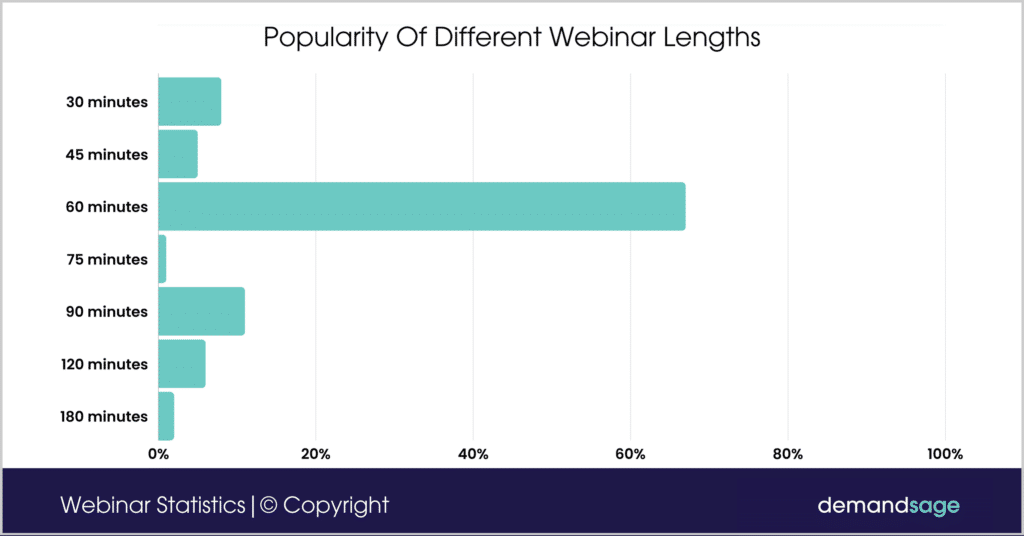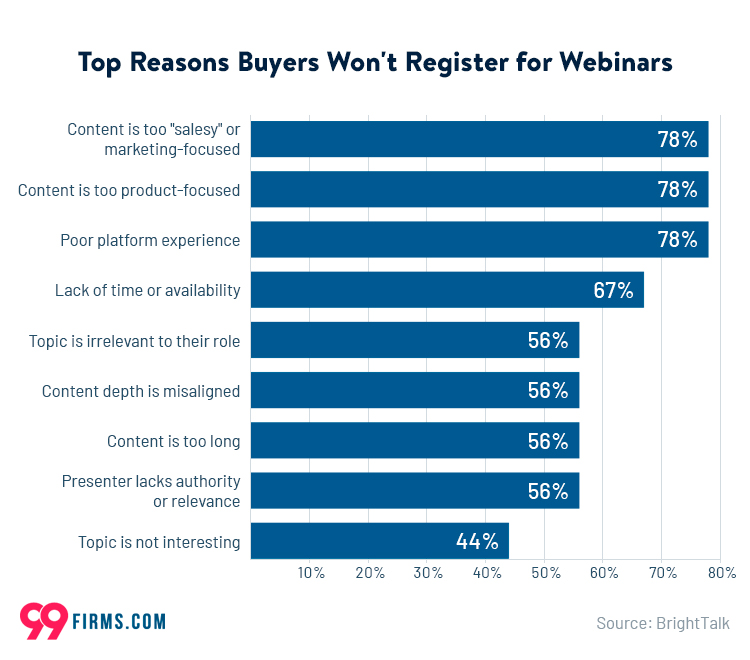You may have hundreds of people attend your webinar, but if you don’t know how they felt after attending, they may not watch future webinars. The key to gauging success is to gather audience insights through a post-webinar survey.
Much like the name suggests, this is a way of gathering direct feedback from webinar attendees. Whether positive or negative, their thoughts will help you determine how informative, engaging, and beneficial your webinars are so you can improve next time.
Read on to learn how to design an effective survey and which questions you should be asking!
What is a post-webinar survey?
A post-webinar survey is a survey you send to attendees after a webinar to get feedback on the delivery of the webinar presentation — whether free or paid. Feedback — both positive and negative — will help you improve future webinars and build an audience of recurring attendees.
Attendee feedback can also help you gauge how successful your webinar was and it can also help you when planning future webinars. The thing to remember with post-webinar surveys, or with any form of event feedback, is that the replies you receive may be positive and negative.
Collecting audience insights can be integral to any other webinars or events you plan to hold. It can cover everything from the timing and length of your webinar to how useful the content was or the quality of the presenters and any guests.
Tip: You can also run surveys before or during a webinar. To learn more, read our full guide on Best Webinar Survey Questions to Ask Before, During, and After!
Tips on designing a post-webinar survey
As the old saying goes, ‘strike while the iron’s hot.’ Ideally, you should be looking at sending any survey within two hours of the event ending. That way, the event is still fresh in participants’ minds and they will have a better recall of things they liked about your webinar (and things they didn’t like).
You also need to consider the length of your survey. Think about any customer surveys you have sent out in the past. A good length for a survey should take around 10-14 minutes to complete. Of course, that restricts how many questions you ask but you can make it a mix of closed questions that require only a yes or no answer, or longer open questions that ask for detail.
You can set up automation so that your survey reaches all attendees in the timeframe you want. You also want as many responses as possible to get a better overview of the different factors that affected the webinar. Think about the questions you ask; with limited scope, you need to focus on what matters to you and what matters to attendees.
10 questions to ask in a post-webinar survey
The questions you ask may be dictated by the subject matter of your webinar series. For example, suppose you host a webinar on contact center solutions. In that case, you may want to know which solutions interested people the most so you can focus on those in future webinars.
However, there may be some questions, such as webinar length, that will be common to most surveys. One good tip is to always start with the easier questions. These can be yes/no, true/false, or even multiple choice.
If participants see easy questions to start, then they are more likely to answer your questions. And, when they come to more open questions later, then they will be more willing to finish what they started.
1. Webinar length

Source: DemandSage
Perhaps the most basic of questions yet also one of the most important. Did the time you held the webinar suit most people or do you need to reconsider the start time? While your webinar may be available on-demand later, many people want to participate in the live event, especially if there are Q&A sessions.
You also want to know if the length of the webinar suited attendees or do you need to look at shortening - or lengthening - future events.
2. Webinar rating
Another straightforward yet crucial question. You may choose to use a sliding scale much as you do in customer satisfaction surveys. You could use a 1-5 scale or a strongly agree to strongly disagree scale. Whatever scale you choose, you have an easily calculable metric that gauges the overall satisfaction. You want to boost webinar attendance and a good rating (and word of mouth) can help achieve that.
3. Guest speakers
A quality webinar will often feature guests as well as a host/presenter. But did you make the right choices and were they relevant to guests? You may decide to cover this in two different questions; a simple yes/no or scaled question to measure overall satisfaction.
And an open question later along the lines of ‘What sort of speakers would you like to see in future webinars?’
4. Likes/dislikes

Source: 99 Firms
There's no one-size-fits-all webinar length but data from Zippia shows that 60 minutes is the most popular length. Whether you spent too long on the introduction or didn't answer enough questions during the Q&A, it can help to know what worked and didn’t work when planning future webinars.
You can either ask this as an open-ended question or, if your presentation is clearly segmented, you could structure it as a multiple-choice question to let attendees easily choose their favorite segment from the webinar.
5. Technical rating
Although secondary to the actual content, the webinar equipment used to host the event is important too so you should be looking to ensure participants were happy with it. That can range from using the right webinar platform to upgrading your camera, microphone, or lighting setup.
Tip: You should also consider pre-recording your presentation to eliminate webinar latency.
6. Key takeaways
You probably had a goal in mind when you designed the webinar and attendees will also have their goals. Asking participants what their main takeaway(s) were can help you determine how many attendees achieved their goals.
7. Topic suggestions
A post-webinar survey is not just about asking questions regarding the webinar just held, it can also be about identifying topics for future webinars. Taking the earlier example of a webinar held on contact center solutions, your survey may indicate that many of the attendees want to see a future webinar that focuses on call monitor software.
8. Content quality
Your webinar may include a degree of accompanying content such as slides or even a video. It’s just as important to appraise that content as it is to appraise the quality of any speaker. Depending on the length of your survey, you can ask this as a closed question or you can dive deeper and ask people to identify what was wrong with any content (or what worked well).
9. Handouts/homework
Many webinars will offer additional materials that can emphasize subjects covered in the webinar or that give extra information. You may even send participants brochures that cover all your products and/or services. Assessing how useful people found any accompanying material can help you plan what to include with future webinars.
10. Other webinars
If you have time (and room) in your post-webinar survey, this can be an interesting question to ask. You could ask what people’s favorite webinar was. This can then give you a competitor to emulate (supposing they didn’t name your webinar). Your other option is to ask for a list of webinars they have attended. This can give you a wealth of ideas for any future events.
Repeating your post-webinar survey
As with other survey types, any relating to your webinar(s) should not exist in a vacuum. You may decide to host regular webinars, even a series that focuses on a general subject and then dives deeper into different parts of that subject.
You should be evaluating any webinars on an ongoing basis so that you can reach a satisfactory level and then seek to maintain or exceed that level. You may find that you have a suitable baseline to measure future webinars against after you gather the appraisal of the first one.
It could even take several events before you’re truly happy with the results.
If you find yourself in the latter scenario, then don’t overthink things. Take the positives and maintain them and look closely at the negatives to see what you can improve or whether any webinar components need to be dropped altogether.
Conclusion
Webinars can be a great tool in many ways. They can increase awareness of your brand and can help establish trust and your positioning as an expert in your field. Just as with other aspects of your business, measuring how well things worked and didn’t work can be crucial when it comes to ongoing success.
There's also little point in conducting a post-webinar survey weeks after the event. You want to ask questions while the memories are still fresh and attendees remember all the details. The sooner you can get feedback, the more accurate and actionable it's likely to be.








